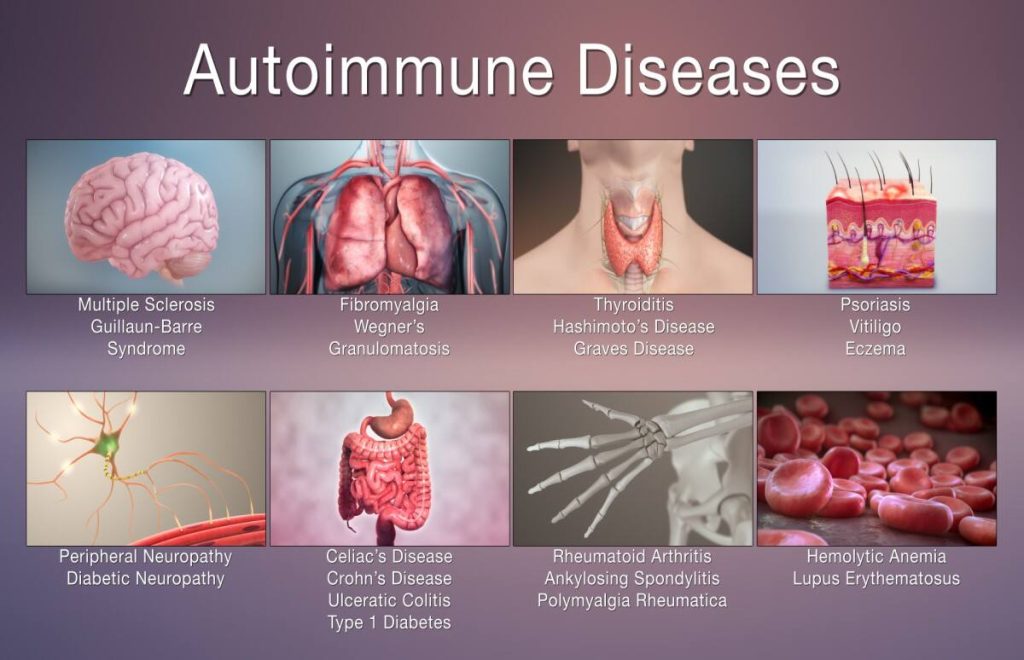An autoimmune disease is a condition in which your immune system mistakenly attacks your body.
The immune system normally guards against germs like bacteria and viruses. When it senses these foreign invaders, it sends out an army of fighter cells to attack them.
Normally, the immune system can tell the difference between foreign cells and your own cells.
In an autoimmune disease, the immune system mistakes part of your body, like your joints or skin, as foreign. It releases proteins called autoantibodies that attack healthy cells.
Some autoimmune diseases target only one organ. Type 1 diabetes damages the pancreas. Other diseases, like systemic lupus erythematosus (SLE), affect the whole body.
Why does the immune system attack the body?
Doctors don’t know exactly what causes the immune-system misfire. Yet some people are more likely to get an autoimmune disease than others.
According to a 2014 study, women get autoimmune diseases at a rate of about 2 to 1 compared to men — 6.4 percent of women vs. 2.7 percent of men. Often the disease starts during a woman’s childbearing years (ages 15 to 44).
Some autoimmune diseases are more common in certain ethnic groups. For example, lupus affects more African-American and Hispanic people than Caucasians.
Certain autoimmune diseases, like multiple sclerosis and lupus, run in families. Not every family member will necessarily have the same disease, but they inherit a susceptibility to an autoimmune condition.
Because the incidence of autoimmune diseases is rising, researchers suspect environmental factors like infections and exposure to chemicals or solvents might also be involved.
A “Western diet” is another suspected risk factor for developing an autoimmune disease. Eating high-fat, high-sugar, and highly processed foods is thought to be linked to inflammation, which might set off an immune response. However, this hasn’t been proven.
A 2015 study focused on another theory called the hygiene hypothesis. Because of vaccines and antiseptics, children today aren’t exposed to as many germs as they were in the past. The lack of exposure could make their immune system prone to overreact to harmless substances.
There are more than 80 different autoimmune diseases. Here are 14 of the most common ones.
1. Type 1 diabetes
The pancreas produces the hormone insulin, which helps regulate blood sugar levels. In type 1 diabetes mellitus, the immune system attacks and destroys insulin-producing cells in the pancreas.
High blood sugar results can lead to damage in the blood vessels, as well as organs like the heart, kidneys, eyes, and nerves.
2. Rheumatoid arthritis (RA)
In rheumatoid arthritis (RA), the immune system attacks the joints. This attack causes redness, warmth, soreness, and stiffness in the joints.
Unlike osteoarthritis, which commonly affects people as they get older, RA can start as early as your 30s or sooner.
3. Psoriasis/psoriatic arthritis
Skin cells normally grow and then shed when they’re no longer needed. Psoriasis causes skin cells to multiply too quickly. The extra cells build up and form inflamed red patches, commonly with silver-white scales of plaque on the skin.
Up to 30 percent of people with psoriasis also develop swelling, stiffness, and pain in their joints. This form of the disease is called psoriatic arthritis.
4. Multiple sclerosis
Multiple sclerosis (MS) damages the myelin sheath, the protective coating that surrounds nerve cells, in your central nervous system. Damage to the myelin sheath slows the transmission speed of messages between your brain and spinal cord to and from the rest of your body.
This damage can lead to symptoms like numbness, weakness, balance issues, and trouble walking. The disease comes in several forms that progress at different rates. According to a 2012 studyTrusted Source, about 50 percent of people with MS need help walking within 15 years after the disease starts.
5. Systemic lupus erythematosus (SLE)
Although doctors in the 1800s first described lupus as a skin disease because of the rash it commonly produces, the systemic form, which is most the common, actually affects many organs, including the joints, kidneys, brain, and heart.
Joint pain, fatigue, and rashes are among the most common symptoms.
6. Inflammatory bowel disease
Inflammatory bowel disease (IBD) is a term used to describe conditions that cause inflammation in the lining of the intestinal wall. Each type of IBD affects a different part of the GI tract.
- Crohn’s disease can inflame any part of the GI tract, from the mouth to the anus.
- Ulcerative colitisaffects only the lining of the large intestine (colon) and rectum.
7. Addison’s disease
Addison’s disease affects the adrenal glands, which produce the hormones cortisol and aldosterone as well as androgen hormones. Having too little of cortisol can affect the way the body uses and stores carbohydrates and sugar (glucose). Deficiency of aldosterone will lead to sodium loss and excess potassium in the bloodstream.
Symptoms include weakness, fatigue, weight loss, and low blood sugar.
8. Graves’ disease
Graves’ disease attacks the thyroid gland in the neck, causing it to produce too much of its hormones. Thyroid hormones control the body’s energy usage, known as metabolism.
Having too much of these hormones revs up your body’s activities, causing symptoms like nervousness, a fast heartbeat, heat intolerance, and weight loss.
One potential symptom of this disease is bulging eyes, called exophthalmos. It can occur as a part of what is called Graves’ ophthalmopathy, which occurs in around 30 percent of those who have Graves’ disease, according to a 1993 studyTrusted
9. Sjögren’s syndrome
This condition attacks the glands that provide lubrication to the eyes and mouth. The hallmark symptoms of Sjögren’s syndrome are dry eyes and dry mouth, but it may also affect the joints or skin.
10. Hashimoto’s thyroiditis
In Hashimoto’s thyroiditis, thyroid hormone production slows to a deficiency. Symptoms include weight gain, sensitivity to cold, fatigue, hair loss, and swelling of the thyroid (goiter).
11. Myasthenia gravis
Myasthenia gravis affects nerve impulses that help the brain control the muscles. When the communication from nerves to muscles is impaired, signals can’t direct the muscles to contract.
The most common symptom is muscle weakness that gets worse with activity and improves with rest. Often muscles that control eye movements, eyelid opening, swallowing, and facial movements are involved.
12. Autoimmune vasculitis
Autoimmune vasculitis happens when the immune system attacks blood vessels. The inflammation that results narrows the arteries and veins, allowing less blood to flow through them.
13. Pernicious anemia
This condition causes deficiency of a protein, made by stomach lining cells, known as intrinsic factor that is needed in order for the small intestine to absorb vitamin B-12 from food. Without enough of this vitamin, one will develop an anemia, and the body’s ability for proper DNA synthesis will be altered.
Pernicious anemia is more common in older adults. According to a 2012 study, it affects 0.1 percent of people in general, but nearly 2 percent of people over age 60.
14. Celiac disease
People with celiac disease can’t eat foods containing gluten, a protein found in wheat, rye, and other grain products. When gluten is in the small intestine, the immune system attacks this part of the gastrointestinal tract and causes inflammation.
A 2015 studyTrusted Source noted that celiac disease affects about 1 percent of people in the United States. A larger number of people have reported gluten sensitivity, which isn’t an autoimmune disease, but can have similar symptoms like diarrhea and abdominal pain.



Comments are closed